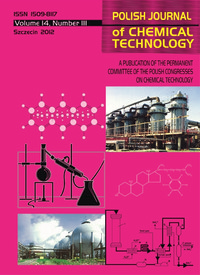Abstract
The influence of organic additives on the process of surface electropolishing of AISI 304 type steel was determined. Additives were selected in initial potentiodynamic tests pursuant to the plateau analysis on the current/potential curves. The assessment of the operational effectiveness of additives consisted in determining the relationship between surface gloss after electropolishing and the mass loss of the sample and in determining surface roughness. The applied electropolishing bath consisted of a mixture of concentrated acids: H3PO4 and H2SO4, and the following organic additives were used: triethylamine, ethanolamine, diethanolamine, triethanolamine, diethylene glycol monobutyl ether and glycerol. The best electropolishing result, i.e. low roughness and high gloss of stainless steel surface with a relatively low mass loss of the sample at the same time were obtained for baths containing triethanolamine.


